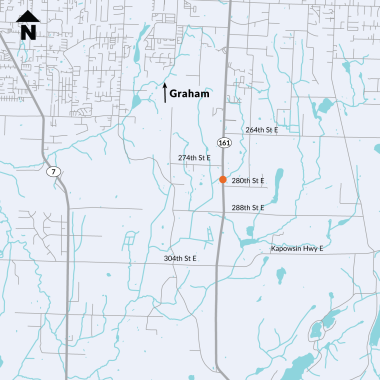Oct. 20-21, expect single-lane alternating traffic during the day near 280th Street East north of Eatonville. This work is weather dependent and may be rescheduled. More information in "What to expect" section below.
Project overview
As part of WSDOT's efforts to remove barriers to fish, this project addresses two blocking culverts where State Route 161 crosses over an Unnamed Tributary to South Creek at milepost 14.85 just north of 280th Street East in Pierce County.
What to expect
If the weather cooperates, people who use both directions of State Route 161 near Eatonville will see daytime road work.
7 a.m. to 4 p.m. Monday and Tuesday, Oct. 20-21:
- Single-lane alternating traffic approaching the work zone.
- Add at least 10 minutes of travel time to help prevent delays.
Contractor crews will apply permanent markings along a new section of roadway.
This work is weather dependent and may be rescheduled.
In September, crews replaced an outdated culvert that blocked fish migration in a stream that flows to South Creek. They installed a new larger culvert and the roadway was freshly paved.
The temporary traffic signal and speed limit reduction of 25 mph were removed on Friday, Oct. 10.
People may notice construction activities off the roadway through late fall while workers finish stream channel restoration and landscaping.
This project is expected to be finished in late fall 2025. Explore progress in the online photo album.
This project will replace two blocking culverts beneath SR 161 between milepost 14.76 and 14.95.
Crews will build a temporary one-lane bypass road near the creek. This will keep people moving while the roadway is excavated. It will allow crews to remove the existing culverts.
Workers will replace the culverts with an 18-foot-long bridge. WSDOT will also make improvements to the creek.
The new bridge and stream enhancements will make it easier for fish to pass through the creek. Both will slow the water and create a more natural environment.
The stream has a seasonal flow. While seasonal streams do dry out, they are still important to fish. For example, streams can sustain young or juvenile coho salmon because there are often residual pools scattered through watersheds where they can wait out the dry periods. In these situations, young fish can benefit from using seasonal streams that dry up in summer. In the Pacific Northwest, it has been documented that juvenile coho salmon using intermittent streams are larger and have a greater chance of survival than streams with year-round flow. Researchers think this may be due to reduced competition for food resources compared to year-round streams.
Our construction project will allow more potential fish habitat to be opened, and it is required to comply with the federal injunction. The injunction required a significant increase in state efforts to remove culverts under state highways that block habitat.

